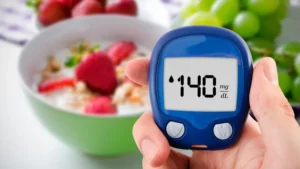Navigating the complexities of diabetes management can be a daunting task, but with the advent of digital health technologies, monitoring your health has never been easier. Among the most crucial metrics for diabetes management is the A1C level, which provides insights into your average blood sugar levels over the past three months. This blog dives into the world of online A1C tests—convenient tools that not only offer you a snapshot of your long-term glucose control but also empower you with the knowledge to make informed decisions about your health.
Contents
Can I Check My A1C At Home?
 Yes, you can check your A1C levels at home using over-the-counter (OTC) A1C test kits, which are readily available online and at many pharmacies. These kits are designed to be user-friendly, allowing individuals to collect a small blood sample—typically through a finger prick—and then send it off to a lab for analysis or, in some cases, get the results at home within minutes.
Yes, you can check your A1C levels at home using over-the-counter (OTC) A1C test kits, which are readily available online and at many pharmacies. These kits are designed to be user-friendly, allowing individuals to collect a small blood sample—typically through a finger prick—and then send it off to a lab for analysis or, in some cases, get the results at home within minutes.
This convenient method of monitoring provides a snapshot of your average blood sugar levels over the past two to three months. And, making it an essential tool for those managing diabetes or prediabetes. While home A1C tests offer the advantage of convenience, it’s important to consider their accuracy compared to the A1C tests conducted in clinical settings. It’s recommended to use them as a supplement to professional care.
How To Take Online A1c Test?
Taking an online A1C test involves a few straightforward steps, allowing individuals to conveniently monitor their average blood sugar levels over the past two to three months from the comfort of their homes. Here’s a guide on how to take an online A1C test:
Choosing Your Test Kit
First, research and select an online A1C test kit that suits your needs. Many reputable companies offer A1C test kits online. Look for kits that promise accuracy and reliability, and check customer reviews for real-world feedback. Once you’ve chosen a kit, place your order. The kit will typically include everything you need to collect a blood sample, including a lancet, a collection device, and instructions for use.
Registering Your Kit
Upon receiving your kit, some companies require you to register it on their website using a unique identifier. This step links your sample to your account, ensuring that you’ll receive your results securely and privately.
Collecting Your Blood Sample
Follow the instructions included with your test kit carefully. Most kits will require you to use a lancet to prick your finger and collect a small sample of blood. It’s important to follow the collection instructions precisely to ensure the accuracy of your test. After collecting your sample, you’ll usually need to place it in a provided container or on a test strip.
Sending Your Sample
Once you’ve collected your blood sample, you’ll need to send it to the designated lab for analysis. Most kits come with a prepaid envelope or package for this purpose. Make sure to send your sample as soon as possible after collection to preserve its integrity.
Receiving and Understanding Your Results
After the lab analyzes your sample, you’ll receive your A1C results. This typically happens through the company’s website or a secure email, depending on the service provider. Your A1C level will be expressed as a percentage, reflecting your average blood glucose levels over the past two to three months. Understanding your results is crucial; an A1C level below 5.7% is considered normal, between 5.7% and 6.4% indicates prediabetes, and 6.5% or higher on two separate tests suggests diabetes.
Following these steps can help ensure that you complete your online A1C test. And accurately understand your diabetes or prediabetes status, aiding in better management of your health.
What Is Normal A1C By Age?
 The A1C test measures the percentage of your red blood cells that have glucose-coated hemoglobin, reflecting your average blood glucose levels over the past two to three months. A normal A1C level can vary slightly among different individuals and across different age groups. However, for most healthy, non-diabetic individuals, the American Diabetes Association (ADA) recommends an A1C level below 5.7% as normal, regardless of age.
The A1C test measures the percentage of your red blood cells that have glucose-coated hemoglobin, reflecting your average blood glucose levels over the past two to three months. A normal A1C level can vary slightly among different individuals and across different age groups. However, for most healthy, non-diabetic individuals, the American Diabetes Association (ADA) recommends an A1C level below 5.7% as normal, regardless of age.
It’s important to note that while the target A1C level for diagnosing diabetes (6.5% or higher) and prediabetes (5.7% to 6.4%) is consistent across most adult age groups, the target A1C for people with diabetes, especially older adults, can vary.
For most adults with diabetes, an A1C goal of less than 7% is recommended to reduce the risk of complications. However, for some older adults, particularly those with a limited life expectancy, severe hypoglycemia risk, or extensive comorbid conditions, less stringent goals (such as <8%) may be appropriate to avoid potential harm. For children and adolescents with type 2 diabetes, the general goal is an A1C of less than 7%.
These targets are guidelines, and individual goals may vary. It’s crucial for individuals, especially those with diabetes, to work closely with their healthcare providers to determine the most appropriate A1C targets for their specific circumstances.
What Are The Pros And Cons Of Online A1c Test?
 Online A1C tests offer a convenient way to monitor one’s blood sugar control over time, particularly for those managing diabetes or prediabetes. However, like any healthcare tool, they come with their own set of advantages and limitations. Here’s a breakdown of the pros and cons of online A1C tests:
Online A1C tests offer a convenient way to monitor one’s blood sugar control over time, particularly for those managing diabetes or prediabetes. However, like any healthcare tool, they come with their own set of advantages and limitations. Here’s a breakdown of the pros and cons of online A1C tests:
Pros
- Convenience and Accessibility: Online A1C tests allow individuals to check their levels at home without needing to schedule a doctor’s visit. And, making it easier for those with busy schedules or limited access to healthcare facilities.
- Privacy: These tests can be done privately, offering individuals comfort and confidentiality in managing their health conditions.
- Proactive Health Management: By enabling more frequent monitoring, online A1C tests can help individuals better understand how lifestyle changes, diet, and medication affect their blood sugar levels over time, encouraging proactive management of their condition.
- Ease of Use: Most at-home A1C kits are designed for easy use, requiring only a simple finger prick and providing clear instructions for sample collection and interpretation of results.
- Prompt Results: Depending on the test kit, results can be available in a matter of minutes (for tests with at-home results) or within a few days (for mail-in laboratory tests). And, allowing for quicker adjustments to health plans if necessary.
Cons
- Accuracy Concerns: While many online A1C tests are quite accurate, the possibility of user error during sample collection or inherent variability in test kits can lead to less reliable results compared to those obtained in a clinical setting.
- Cost: Some online A1C tests can be expensive, and not all are covered by insurance. This out-of-pocket expense might be a barrier to regular monitoring for some individuals.
- Lack of Comprehensive Analysis: An A1C test provides a broad overview of blood sugar control but doesn’t offer the nuanced understanding that might come from a full panel of tests and a professional consultation in a clinical environment.
- Potential for Misinterpretation: Without proper medical guidance, there’s a risk of misinterpreting test results. This could lead to unnecessary anxiety or complacency regarding one’s health condition.
- False Sense of Security: Regularly normal A1C results might lead some individuals to neglect other important aspects of diabetes management, such as daily blood sugar monitoring. Especially if they perceive the A1C result as the sole indicator of their health status.
Overall, online A1C tests can be a valuable tool for individuals looking to manage their diabetes or monitor their blood sugar levels. However, it’s crucial to use these tests as part of a broader health management strategy. And, ideally in consultation with a healthcare professional. So, they will help to ensure accurate interpretation and appropriate action based on the results.

